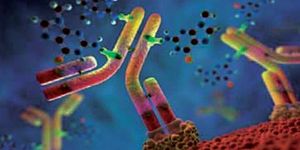Bats may be able to defend against pathogens differently than other mammals because their immunological first line of defense is totally unique.
Toll-like receptors (TLRs) are employed by the immune system as first responders to invading pathogens, warning the rest of the lymphocyte army that a foreign particle is present through a mechanism called pattern recognition (
Nature). In a recent study published in
Molecular Ecology, scientists discovered that bat TLRs perform pattern recognition differently than other mammals, enabling them to recognize pathogens differently, potentially more efficiently.
Scientists believe this unique ability of the bats' non-specific immune response may explain why bat species suffer less from pathogens that severely disable other mammal species. They are also beginning to draw connections from this discovery to the cases where bats serve as resevoirs for disease. Perhaps if bats can detect pathogens early, they can provide enhanced immunity to infection.
TLRs recognize unique characteristics on pathogens such as "molecular signatures" and nucleic acids. Distinctive mutations can be seen in bat TLRs that affect how they recognize different pathogens. What is it about these genetic changes that helps bats receive unique signals differently than other mammals? Scientists are still looking into the molecular differences.
"The genetic variability of the bat immune system has been little investigated," the team reported.
In addition to unique TLRs, bats also exhibit other unique traits from other mammals. Their ability to take flight and "exceptional breadth in diet" are linked to their ability to fulfill a wide variety of niches.
"These niches also have specific pathogen profiles which are likely to have shaped the evolution of bat TLRs in an order-specific manner," theorized lead author Dr. Marina Escalera.
Watch the video below to see an animation of the molecular characteristics of TLRs.
Source:
Forschungsverbund Berlin e.V.









